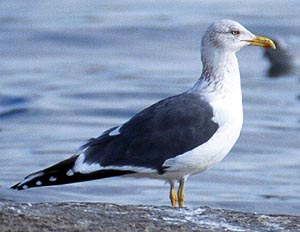Lesser Black-backed Gull
Salton Sea State Recreation Area
Riverside County, California
23 November 2001
Joseph Morlan
 Robbie Fischer
and I decided to make a stop at the Salton Sea State Recreation Area at the northeast end of the Salton Sea to
look for the returning Lesser Black-backed Gull which had been reported. About 2:30 pm, we drove to the end of
the small parking area just south of the pond south of the visitors' center and quickly found the gull by itself
in the cove to the south.
Robbie Fischer
and I decided to make a stop at the Salton Sea State Recreation Area at the northeast end of the Salton Sea to
look for the returning Lesser Black-backed Gull which had been reported. About 2:30 pm, we drove to the end of
the small parking area just south of the pond south of the visitors' center and quickly found the gull by itself
in the cove to the south.
We watched it pick up, what appeared to be barnacles and swallow them whole, eventually resulting in a bulging lump in its crop. Several other birders came by and saw the bird also.
An additional photo of this bird from 1998 is here.
The following description is based on notes taken while watching the bird:
The only dark-mantled gull present, it was larger than adjacent Ring-billed Gulls, but seemed slightly smaller than nearby Herring Gulls. The bright yellow eye and yellow legs and feet were immediately evident. Yellow-footed Gull was eliminated, in part, by the bill which was quite slender without much of a gonydeal angle. The bill was dull yellow at the base and darker yellow at the tip. The red spot spread laterally forming a broad oval-shaped patch on the lower mandible. The culmen curved gradully from the middle of the bill.
The white head was heavily streaked and mottled, with a particularly dark smudge in front of the eye. Extensive, gray smudging extended down onto the white breast. Otherwise the body and tail were white.
The mantle was dark gray, not black consistent with the subspecies L. f. graelsii. The scapular and tertial crescents were white. The tips of the secondaries were also white giving the effect of a white apron along the trailing edge of the folded wing. The primary tips were black with small white apical spots. One mirror was visible on p10.
There appeared to be a molt limit on the primaries with one fresh primary visible at the mid-point of the primary extension past the tertial crescent, contrasting with the more worn outer primaries.